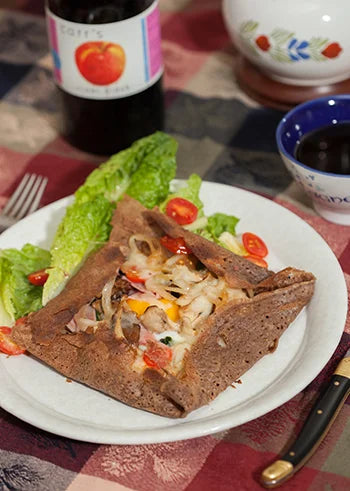When you hop out of your vehicle and wander through the medieval walls into the center of Saint-Malo, Britttany, it is quickly clear that there is no doubt what you are going to be eating for your next meal: Galettes & Crepes! Literally every other storefront is a Creperie and each follow a very similar, carefully honed formula of serving Savory Buckwheat Galettes for your main dish, followed by white-flour Crepes for your sweet finish. Until I’d been to Brittany, before I met Franck, I’d never tried a Buckwheat Crepe. In the States we have tended to overlook them and save buckwheat for pancakes (which is a beautiful thing to do, don’t get me wrong). Buckwheat crepes, or “Galettes” as they’re known in Brittany, however, are something special for many reasons.
S
Buckwheat happens to be a really nutritious fruit seed, related to rhubarb & sorrel and not at all related to wheat or other grains in any way. Known as “farine de sarrasin” in French, it”s high in phytonutrients, minerals, B vitamins, and is a superior source of protein than many grains. It’s also really satisfying and helps control blood sugar. The interesting thing about working with buckwheat flour is that since it’s completely gluten-free, it needs to be worked fairly hard. Originally I thought this must be developing some kind of “gluten-like” strength in the flour. Franck distinctly remembers the “thwack thwack” of the wooden spoon in the bowl as his grandmother or mother mixed their galette batter hard for quite a long time. When we (who can’t be bothered to mix many things by hand, actually) put all of the ingredients together in the Kitchen Aid, we let the flat beater work the mix at medium speed for more than five minutes, or the galettes are too fragile. In fact, before I was focusing on gluten-free cooking and baking, my mother-in-law had instructed me to add a spoonful of wheat flour to the mix, which I think was her way to make it easier for the batter to come together by strengthening it with a little gluten. In any case, we now make our mix 100% gluten free by using only buckwheat flour, and occasionally a spoonful of gluten-free flour mix just to lighten up the flavor a bit, since buckwheat is strong. By working it very long and hard either with a wooden spoon or the beater of the mixer, you are actually gelatinizing the starches in the buckwheat which help make the mix hold together better. After that it’s good (but not essential) to let the mix rest in the fridge to fully hydrate the flour. The final mix should have the consistency of heavy cream. It will thicken during the resting time and then you can thin it out with a bit more water before cooking. Your first galette will be your test for consistency: a thinner mix allows a lacy, crispy galette which has a toasty, warm buckwheat flavor. It’s addictive!
tThe traditional galettes in Brittany are served with a number of savory fillings, making them completely fun and versatile for the cook. We usually put out a bunch of popular choices, and everyone can customize their meal. A nice fresh egg cracked over the top is the most classic finish to a true “Galette Complete”, whether you put ham, spinach, cheese, tomato, mushrooms or ratatouille inside.
Buckwheat Crepe (Galette)
2 c buckwheat flour
1 egg (optional if you want vegan)
1/2 t salt
1 c beer (optional)
4 c water (plus one or two more cups)
In a large mixing bowl or Kitchen Aid bowl, place your ingredients and mix thoroughly for at least 5 minutes. We like to use a little beer (hard cider would be appropriate to Brittany, too), as this gives even more flavor and lightness to the mix. Many folks (including my sweet mother-in-law) skip the beer, though, so it’s not essential. Add water until the mix has the consistency of heavy cream. As the mixture beats, the buckwheat gelatinizes and the batter gets a satiny sheen to it. Transfer to a container and let rest in the fridge 30 minutes-a few hours.
Heat a heavy skillet, non-stick pan, or crepe pan over medium heat, then grease with plain oil. Rub the oil to a thin, even coat with a folded-up paper towel, then ladle the batter into the pan, turning with your wrist as you pour to evenly spread the mix. This is not easy at first (the mix pours slowly since it’s a bit heavier than a white-flour crepe mix). Spread with a thin spatula if that helps. Let the galette set and start to brown, then put about 1/2 t of butter in the pan and flip to cook the other side, about 2 minutes per side. You can continue to cook galettes in this way, and pile them up on top of one another on a dinner plate. This can be done in advance, and then you can finish them in the pan later with everyone’s preferred fillings and serve them hot.
For fillings you can slice ham, sauté spinach, sauté mushrooms, slice tomatoes, grate cheddar or swiss cheese. Grilled sausages are really popular rolled into a fresh, buttery galette, or we like to julienne and sauté root veggies and roll them up as a side dish to fish with a beurre blanc sauce. Enjoy the chance to get creative with your galettes; if you’re being really classical, though, you won’t put a sweet filling inside (Franck cringes when I spread them with jam, but it’s absolutely delicious. The French are just so traditional this way, it’s amazing).

